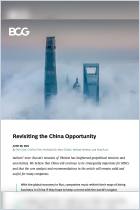It wasn’t so very long ago that global companies looked down their nose at Chinese companies for lacking a recognizable brand and internal innovation, but China has moved on from copying successful Western products. This is true in manufacturing, and it’s now true in the biopharma industry, as favorable government policy and cheap funding help Chinese companies emerge and expand. They may soon be encroaching on the global markets of established multinationals. So how might current biopharma companies collaborate with new Chinese companies? The Boston Consulting Group have some ideas.
China is the second-largest market for biopharmaceuticals after the United States, and it’s only going to grow.
The United States is still the world’s largest market for biopharmaceuticals, but with an aging population, China’s market will almost certainly experience more growth over the next five years. Projections suggest China’s market will grow in the higher single digits. Biopharmaceutical multinational corporations (MNCs) need to sit up and take notice.
Over the past decade, China has produced more than 140 new biopharma companies, spurred on by government support in the form of talent development, funding and policy reform. If US companies want to continue to benefit from the growing Chinese market, they’ll have to learn from Chinese innovation. They’ll also have to address their failure to put adequate research into the diseases like HBV, gastric, HCC and esophageal cancers, which are more prevalent in China than the West. They’ll also have to make sure they make the Chinese government’s National Reimbursement Drug List.
The Chinese government is supporting its biopharma companies through...
John Wong, Chun Wu, Wen Xie and Vaidyanathan Srikant are professionals with the Boston Consulting Group. They collaborated from the BCG’s Hong Kong, Beijing and Zurich offices.















Comment on this summary